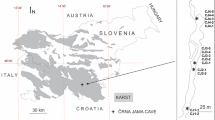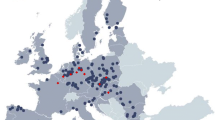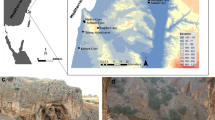Abstract
Karst caves are important tourism and natural heritage destinations. Within dry cave passages otherwise notable for their rich flowstone decoration, areas with a characteristic black color can sometimes be observed on cave walls and floors and on speleothems. To determine the origin of these black deposits, mineralogical and chemical analyses were carried out in two caves (Postojna Cave and Črna Jama (Kočevje), Slovenia). Qualitative chemical composition was obtained by scanning electron microscopy in conjunction with energy dispersive X-ray spectrometry (SEM/EDS). Organic matter in black deposits was confirmed by the Walkley–Black (wet burning) and loss-on-ignition (LOI, dry burning) methods. Results showed that black deposits from the caves studied could be attributed to natural and anthropogenic causes. Natural causes are related to Mn–Fe oxide precipitation and are probably dependent on microorganism activity. Anthropogenic sources are related to historic (or/and prehistoric) human activities such as cave visitors using torches and fires, events outside the caves such as forest and settlement fires, and recent air pollution. Black deposits show the effect of long-term environmental impact on karst caves and could be included in guided tours of show caves along with a scientific explanation of their causes and origin.







Similar content being viewed by others
References
Benington F, Melton CW (1961) An examination of brown-black ceiling deposits from Mammoth and Salts Cave. NSS News 19:91
Buser S (1974) Osnovna geološka karta SFRJ. L 33-76, Ribnica. 1:100.000. Zvezni geološki zavod, Beograd
Chang SJ, Jeong GY, Kim SJ (2008) The origin of black carbon on speleothems in tourist caves in South Korea: chemical characterization and source discrimination by radiocarbon measurement. Atmosph Environ 42:1790–1800. doi:10.1016/j.atmosenv.2007.11.042
Culver DC, Debevec B, Knez M, Kovačič G, Kranjc A, Mulec J, Pipan T, Prelovšek M, Ravbar N, Semeja A, Slabe T, Šebela S, Zupan Hajna N (2012) Karstology and development challenges on karst II, construction, tourism, ecology, protection. ZRC Publishing, Postojna-Ljubljana
Dozet S, Kanduč T, Markič M (2012) A contribution to petrology of dark grey to black interbeds within Upper Permian and Triassic carbonate rocks in the area between Ljubljana and Bloke, Central Slovenia. Geologija 55:77–92. doi:10.5474/geologija.2012.006
Fernandes MB, Skjemstad JO, Johnson BB, Wells JD, Brooks P (2003) Characterization of carbonaceous combustion residues. I. Morphological, elemental and spectroscopic features. Chemosphere 51:785–795. doi:10.1016/S0045-6535(03)00098-5
Gabrovšek F, Knez M, Kogovšek J, Mihevc A, Mulec J, Perne M, Petrič M, Pipan T, Prelovšek M, Slabe T, Šebela S, Ravbar N (2011) Development challenges in karst regions: sustainable land use planning in the karst of Slovenia. Carbon Evapor 26:365–380. doi:10.1007/s13146-011-0072-3
Gentles DS, Smithson PA (1986) Fires in caves: effects on temperature and airflow. Proc Univ Bristol Spelaeol Soc 17:205–217
Ghiorse WC (1984) Biology of iron- and manganese-depositing bacteria. Ann Rev Microbiol 38:515–550
Gradziński M, Górny A, Pazdur A, Pazdur MF (2003) Origin of black coloured laminae in speleothems from the Kraków-Wieluń Upland, Poland. Boreas 32:532–542
Gregorič A, Vaupotič J, Gabrovšek F (2013) Reasons for large fluctuation of radon and CO2 levels in a dead-end passage of karst cave (Postojna Cave, Slovenia). Nat Haz Earth Syst Sci 13:287–297. doi:10.5194/nhess-13-287-2013
Gregorič A, Vaupotič J, Šebela S (2014) The role of cave ventilation in governing cave air temperature and radon levels (Postojna Cave, Slovenia). Int J Climatol 34:1488–1500. doi:10.1002/joc.3778
Habe F (1986) The Postojna caves and other tourist caves in Slovenia. Tone Tomšič Printing House, Ljubljana
Hill CA (1982) Origin of black deposits in caves. Nat Speleol Soc Bull 44:15–19
ISO Sist 14235 (1999) Soil quality—Determination of organic carbon by sulfocromic oxidation. SIST, Ljubljana
Ivarsson Norbäck L, Ivarsson M, Lundberg J, Sallstedt T, Rydin C (2013) Epilithic and aerophilic diatoms in the artificial environment of Kungsträdgården metro station, Stockholm, Sweden. Int J Speleol 42:289–297
Jamnik P, Leben-Seljak P, Bizjak J, Horvat B (2002) Anthropological analysis of the skeletal remains with a description of the grave goods. Arheol vestnik 53:31–49
Jeong GY, Kim SJ, Chang SJ (2003) Black carbon pollution of speleothems by fine urban aerosols in tourist caves. Am Miner 88:1872–1878
Karltun E, Saarsalmi A, Ingerslev M, Mandre M, Andersson S, Gaitnieks T, Ozolinčius R, Varnagiryte-Kabasinskiene I (2008) Wood ash recycling—possibilities and risks. In: Röser D, Asikainen A, Raulund-Rasmussen K, Stupak I (eds) Sustainable use of forest biomass for energy. A synthesis with focus on the Baltic and Nordic Region, Springer, pp 79–108
Moore GW (1981) Manganese deposition in limestone caves. In: Beck BF (ed) Proceedings of the Eight International Congress of Speleology, 18–24th July 1981, Vls I and 2. International Union of Speleology, Bowling Green, pp 642–644
Moore GW, Sullivan N (1978) Speleology—the study of caves. Cave books, St. Louis
Mulec J (2014) Human impact on underground cultural and natural heritage sites, biological parameters of monitoring and remediation actions for insensitive surfaces: case of Slovenian show caves. J Nat Conserv 22:132–141. doi:10.1016/j.jnc.2013.10.001
Muri G, Jovičić A, Mihevc A (2013) Source assessment of deposited particles in a Slovenian show cave (Postojnska jama): evidence of long-lasting anthropogenic impact. Int J Speleol 42:225–233. doi:10.5038/1827-806X.42.3.6
Onac BP, Pedersen RB, Tysseland M (1997) Presence of rare-earth elements in black ferromanganese coatings from Vântului Cave (Romania). J Cave Karst Stud 59:128–131
Papier S, Baele J-M, Barriquand L, Barriquand J (2011) Manganese geomicrobiology of the black deposits from the Azé Cave, Saône-et-Loire, France. Quaternaire 4:297–305
Politi I (1939/40) Sui fenomeni di annerimento delle formazioni calcitiche e calcaree nelle Grotte di Postumia. Grotte Ital 4:18–23
Ravbar N, Košutnik J (2014) Variations of karst underground air temperature induced by various factors (Cave of Županova jama, Central Slovenia). Theor Appl Climatol 116:327–341. doi:10.1007/s00704-013-0955-4
Rodriguez-Navarro C, Ruiz-Aguido E, Luque A, Rodriguez-Navarro AB, Ortega-Huertas M (2009) Thermal decomposition of calcite: Mechanisms of formation and textural evolution of CaO nanocrystals. Am Miner 94:578–593
Saiz-Jimenez C (2012) Microbiological and environmental issues in show caves. World J Microbiol Biotechnol 28:2453–2464. doi:10.1007/s11274-012-1007-x
Šebela S (2012) Postojna Planina Cave System, Slovenia. In: White WB, Culver DC (eds) Encyclopedia of caves. Academic Press, Elsevier, pp 618–624
Šebela S, Turk J (2011a) Local characteristics of Postojna Cave climate, air temperature, and pressure monitoring. Theor Appl Climatol 105:371–386. doi:10.1007/s00704-011-0397-9
Šebela S, Turk J (2011b) Air temperature characteristics of the Postojna and Predjama cave systems. Acta geogr Sloven 51:43–64. doi:10.3986/AGS51102
Šebela S, Turk J (2014a) Natural and anthropogenic influences on the year-round temperature dynamics of air and water in Postojna show cave, Slovenia. Tourism Manag 40:233–243. doi:10.1016/j.tourman.2013.06.011
Šebela S, Turk J (2014b) Sustainable use of the Predjama Cave (Slovenia) and possible scenarios related to anticipated major increase in tourist numbers. Tourism Manag Perspect 10:37–45. doi:10.1016/j.tmp.2014.01.002
Šebela S, Prelovšek M, Turk J (2013) Impact of peak period visits on the Postojna Cave (Slovenia) microclimate. Theor Appl Climatol 111:51–64. doi:10.1007/s00704-012-0644-8
Smith T, Olson R (2007) A taxonomic survey of lamp flora (Algae and Cyanobacteria) in electrically lit passages within Mammoth Cave National Park, Kentucky. Int J Speleol 36:105–114
Spilde MN, Northup DA, Boston P (2006) Ferromanganese deposits in the caves of the Guadalupe Mountains. New Mexico Geol Soc Guidebook, 57th Field Conference, Caves and Karst of Southeastern New Mexico, pp 161–166
Steelman KL, Rowe MW, Boutton TW, Southon JR, Merrell CL, Hill RD (2002) Stable isotope and radiocarbon analyses of a black deposit associated with pictographs at Little Lost River Cave, Idaho. J Archaeol Sci 29:1189–1198. doi:10.1006/jasc.2001.0791
Tasić M, Đurić-Stanojević B, Rajšić S, Mijić Z, Novaković V (2006) Physico-chemical characterization of PM10 and PM2.5 in the Belgrade Urban Area. Acta Chim Sloven 53:401–405
Tebo BM, Ghiorse WC, van Waasbergen LG, Siering PL, Caspi R (1997) Bacterially mediated mineral formation: insights into manganese(II) oxidation from molecular genetic and biochemical studies. Rev Mineral 35:225–266
Tebo BM, Bargar JR, Clement BG, Dick GJ, Murray KJ, Parker D, Verity R, Webb SM (2004) Biogenic manganese oxides: properties and mechanisms of formation. Annu Rev Earth Planet Sci 32:287–328. doi:10.1146/annurev.earth.32.101802.120213
Umbria A, Galán M, Muñoz MJ, Martín R (2004) Characterization of atmospheric particles: analysis of particles in the Campo de Gibraltar. Atmósfera 17:191–206
van Beynen P, Bourbonniere R, Ford D, Schwarcz H (2001) Causes of colour and fluorescence in speleothems. Chem Geol 175:319–341
Vassilev SV, Baxter D, Andersen LK, Vassileva CG (2013) An overview of the composition and application of biomass ash. Part 1. Phase-mineral and chemical composition and classification. Fuel 105:40–76. doi:10.1016/j.fuel.2012.09.041
White WB (1997) Color of speleothems. In: Hill C, Forti P (eds) Cave minerals of the world, 2nd edn. Natl Speleolog Soc, Huntsville, pp 239–244
White WB, Vito C, Scheetz BE (2009) The mineralogy and trace elements chemistry of black manganese oxide deposits from caves. J Cave Karst Stud 71:136–143
Zhang H, Shi M, Shen W, Li Z, Zhang B, Liu R, Zhang R (2013) Damage or protection? The role of smoked crust on sandstones from Yungang Grottoes. J Archaeol Sci 40:935–942. doi:10.1016/j.jas.2012.09.031
Zupančič N, Šebela S, Miler M (2011) Mineralogical and chemical characteristics of black coatings in Postojna Cave System. Acta Carsol 40:307–317
Acknowledgments
This study was performed within the Karst Research Programme (P6-0119), project Measurements and Analysis of Selected Climatic Parameters in Karst Caves: Example of the Postojna Cave System (L6-2156), project Assessment of natural and anthropogenic processes in micrometeorology of the Postojna cave system by numerical models and modern methods of data acquisition and transfer (L2-6762), research programme Mineral resources (P1-0025), Paleontology and sedimentary geology (P1-0008), and IGCP Project 567 Earthquake Archaeology. Thanks are due to Postojnska jama d.d. for allowing us to take samples in Postojna Cave and to Dr. Helena Grčman (University of Ljubljana, Biotechnical Faculty, Department of Agronomy, Chair of Soil Science and Environmental Protection) for the organic matter analyses. All samples were collected by permission of the Nova Gorica unit of the National Nature Conservation Institute (Zavod Republike Slovenije za varstvo narave). We are thankful to Hugh Brown for revising the English and to reviewers for constructive comments and useful suggestions, which improved the manuscript.
Author information
Authors and Affiliations
Corresponding author
Rights and permissions
About this article
Cite this article
Šebela, S., Miler, M., Skobe, S. et al. Characterization of black deposits in karst caves, examples from Slovenia. Facies 61, 6 (2015). https://doi.org/10.1007/s10347-015-0430-z
Received:
Accepted:
Published:
DOI: https://doi.org/10.1007/s10347-015-0430-z




